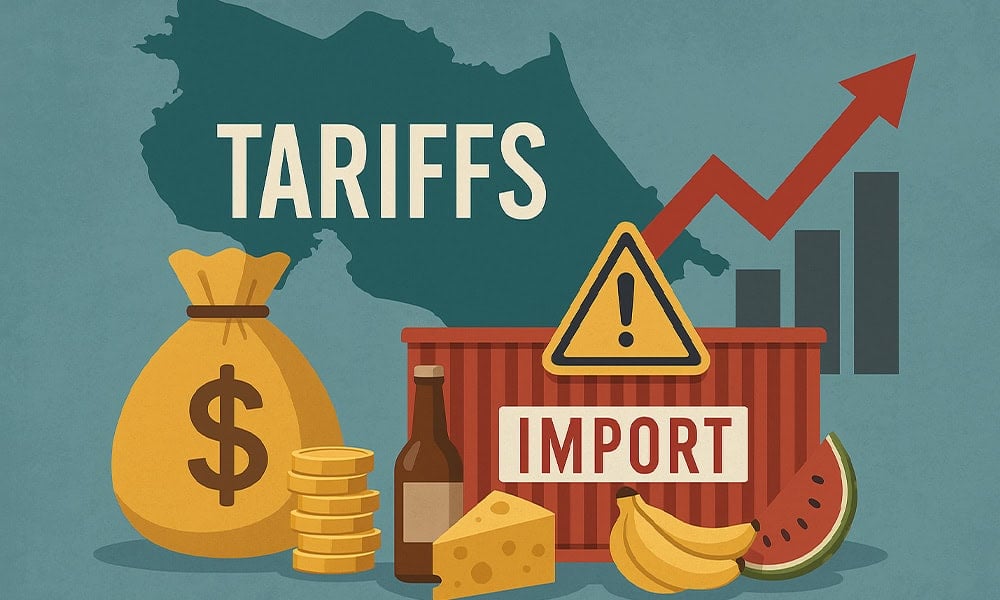Photo: The Tico Times
As of July 2025, former President Donald Trump has announced a sweeping new round of tariffs that’s already stirring up headlines—and markets. If you’re an investor, a homeowner, or just an average U.S. citizen wondering what this means for your wallet, your home, and your future, here’s what you need to know.
What Just Happened?
Trump is rolling out 30% tariffs on goods from the European Union and Mexico, and a 35% tariff on Canadian imports, effective August 1, 2025.
These tariffs are being framed as a response to:
- Unfair trade practices
- National security concerns
- The fight against fentanyl trafficking, particularly through Mexico and Canada
This aggressive move adds to existing tariffs on steel, automobiles, pharmaceuticals, and consumer electronics. While aimed at protecting American manufacturing, the ripple effects will be felt across the economy—and in your daily life.
How Does This Affect You as an Investor?
1. Market Volatility is Back
Markets have already reacted. U.S. stock futures dipped and global indexes slipped as investors braced for possible retaliation from trade partners. If you’re investing in multinational companies or sectors reliant on imported materials, brace for some choppy waters.
2. Inflation Pressure is Rising
Tariffs act like taxes on imports. That cost usually gets passed on to businesses and, ultimately, consumers. Goldman Sachs and other analysts project a 1.5%–1.8% increase in inflation as a result—pressuring earnings and possibly altering Federal Reserve interest rate decisions.
3. Sector Shifts to Watch
- Winners: U.S.-based steel, aluminum, and some manufacturing companies could benefit from reduced competition.
- Losers: Auto manufacturers, tech companies, and retailers reliant on global supply chains may suffer.
Tip: If you’re a long-term investor, stay diversified and avoid panic-selling. There may be opportunities in defensive sectors or undervalued U.S.-focused companies.
What This Means for Homeowners
1. Rising Construction Costs
Tariffs on Canadian lumber and steel could raise the cost of building and renovating homes. Builders may pass these costs on to buyers, impacting affordability.
2. Utility and Fuel Bill Surprises
With potential tariffs on energy-related goods, homeowners could see higher costs for electricity, natural gas, and fuel. Expect tighter household budgets, especially heading into the colder months.
3. Mortgage Rate Watch
If inflation spikes and the Fed decides to keep interest rates higher for longer, mortgage rates may also rise, making it more expensive to buy or refinance a home.
What About the Average American?
Whether you invest or own a home or not, these tariffs are likely to impact you.
Everyday Impacts:
- Higher Prices at Checkout: Electronics, appliances, groceries, and even cars could all see price increases.
- Lower Disposable Income: According to economists, the average American household could pay $1,200 to $1,800 more annually due to higher prices on imported goods.
- Job Uncertainty: If other countries retaliate with their own tariffs, U.S. exports—especially in agriculture and manufacturing—may suffer. That could lead to job cuts in already vulnerable sectors.
What Comes Next?
The August 1 deadline is key. It’s possible that negotiations will happen behind the scenes, and some of these tariffs could be reduced or postponed. But if they go into full effect, expect inflation to remain a top concern—and ripple effects to spread across nearly every corner of the economy.
Final Thoughts
Trump’s July 2025 tariffs are more than just political headlines—they’re a direct hit to global trade and an indirect tax on American consumers. Whether you're managing a portfolio, buying a home, or just trying to stretch your monthly budget, these policy changes are something you can't ignore.
Stay informed. Adjust where you can. And keep a close eye on how Washington—and Wall Street—responds in the weeks ahead.


